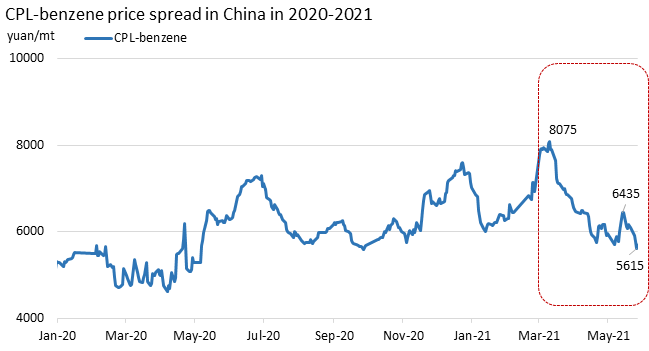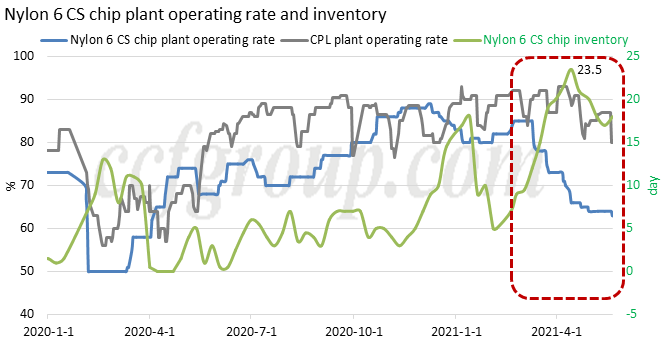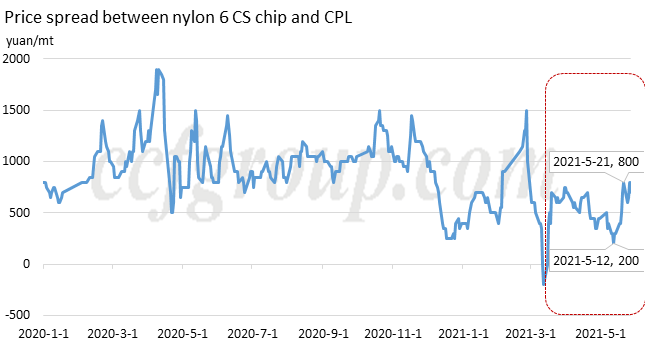A surprised sharp decline in caprolactam
- Benzene prices dropped with bulk commodity market
- CPL saw heavy decline, downstream nylon prices followed down
- CPL-benzene margin squeezed significantly
- Reasons behind larger-than-expected CPL price drop
Benzene prices dropped with bulk commodity market
In the third week in May 2021, China’s rapidly rising commodity market started an overall downward adjustment, and prices in the energy and chemical industry also dropped quickly. Benzene and styrene prices declined heavily on May 13, and the decline continued this week. The drop came after that China’s regulators determined to control recent fast price rise in commodity market.
“On May 23, the National Development and Reform Commission of China, together with other four central departments, held a meeting on the rapid commodity price gains in 2021, warning key enterprises in the bulk commodity sector to maintain normal market order.
The talks came after Premier Li Keqiang chaired the State Council's Executive Meeting on Wednesday (May 19), calling for careful analysis of reasons for the recent spate of rapid commodity prices increases and adopting measures in a targeted and holistic approach to ensure the supply of commodities and keep their prices stable.”
CPL saw heavy decline, downstream nylon prices followed down
Since benzene price was the major driving force behind nylon market uptrend in April 2021, this round of decline in benzene surely affected nylon market. It is almost a common knowledge shared by the insiders of nylon industrial chain. Although the decline has been expected, the speed of the downturn seems to be too fast in the past two weeks.
| Product/time (unit: yuan/mt) | May 17 | May 21 | May 26 | Accumulated decline |
| Benzene | 8180 | 7740 | 7650 | 530 |
| Styrene | 10800 | 10050 | 10100 | 700 |
| Caprolactam | 14300 | 13800 | 13300 | 1000 |
| Nylon 6 CS chip | 14700 | 14600 | 14100 | 600 |
* CS = conventional spinning
The above figure shows price shift in benzene, styrene, CPL and nylon 6 CS chip since May 17. The decline of CPL spot has been most significant at 1,000yuan/mt, almost doubling the drop in benzene, and even more than the drop in styrene, which has been considered overvalued in the past months. As a core indicator of nylon 6 industrial chain, the dramatic fall in CPL has heavily damaged the confidence of the whole industrial chain.
CPL-benzene margin squeezed significantly

After the cliff-like shift, CPL-benzene price spread lowered from 6,450yuan/mt on May 14 to 5,615yuan/mt, evidently under the previous acknowledged break-even line (6,000yuan/mt) for CPL production from benzene. But the actual situation for CPL plants is worse, since its production cost has been elevated greatly during this round of price increase in the bulk commodity market since the Chinese New Year to now, meaning almost all related cost had risen up. CPL plants are surely under deficits now.
And this trend of narrowing CPL-benzene spread seems continue, begetting more losses in CPL production in the last days of May.
Reasons behind larger-than-expected CPL price drop
Why CPL price drops so much? More specifically speaking, the question is why CPL spot price drops so quickly. When spot CPL prices quickly fell, the contract prices seemed to be relatively stable. Sinopec cut down its weekly guidance price by 300yuan/mt to 14,400yuan/mt for the week starting May 24, and the gap with spot CPL prices widened to as high as 1,200yuan/mt.
The key problem to the larger-than-expected decrease in CPL is on its supply and demand side, and the problem is severe within several manufacturers.

Since early March, nylon 6 conventional spinning (CS) chip plants have lowered their operating rate continuously from 84% to 63% by May 21. But CPL plant operating rate was basically kept high around 85% before May 18, and only dropped to 80% since May 19. The inventory in CS chip plants had accumulated to as high as 23.5 days in mid-April, and gradually fell to 7 day by May 14.

The price spread between nylon 6 CS chip and CPL spot had been condensed evidently in April-May as well. In the above chart, the price differential between CS chip and CPL spot had been pegged around 1,000yuan/mt in the year of 2020, and the rate fluctuated sharply in 2021, with the average rate in April-May dropping to only 522yuan/mt. This website has reviewed the comprehensive situation facing CS chip market in the insight Is nylon 6 CS chip industry facing a reshuffle?. These figures had showed that nylon 6 CS chip plants had been through a very difficult time in the second quarter of 2021.
The long term poor performance in CS chip market certainly exerts pressure on CPL market. However, there are several CPL makers facing the impact more directly. High-end CPL manufacturers are supply to the contract buyers only, they are mostly nylon 6 high-speed spinning chip plants (who also sell chips through contract to textile filament plants) and some conventional spinning chip makers. The fulfilment of CPL and HS chip contract in 2021 is generally smooth, so contract CPL plants are still free from inventory pressure.
The pressure is mainly on lower-grade CPL producers, who mainly sell to CS chip plants. Even though, inventory problem is not prominent if you see the average rate of the market. But several manufacturers, due to less flexible sales strategy, have seen their stock piling up evidently. As a liquid chemical, CPL needs to be stored in particular tank and the storage has a limit. Once the stock rate is reaching to the upper limit, sellers have to dump goods. The inventory-triggered sales promotion has coincided with the bearish impact of benzene, and it incurred the faster-than-expected fall in CPL spot in late May. With the leaky bucket effect, other CPL plants also adjusted down the spot offers, suddenly from above 14,000yuan/mt to below 13,600yuan/mt and to 13,200yuan/mt, by May 28.
Logic of CPL price decline:
- CPL spot market was much weaker than contract.
- Nylon 6 CS chip plants cut production actively since March, while CPL plants’ run rate was relatively high.
- CS chip margin against CPL condensed heavily in April-May.
- CS chip plants were the main consumer of lower-end spot CPL.
- Inventory pressure in some plants and bearish benzene impact dragged price down quickly.
Will CPL market continue falling? It is most concerned in the market right now, as CPL development is directly influencing downstream polymer makers' strategy. This website holds that CPL spot may have very limited downward fluctuation in short. First, the promotion is just in a small number of plants, and the average CPL inventory is still controllable. Second, CPL plants are already under deficits, and they are very reluctant to lose more profit. Third, some CPL plants including Yangmei and Fangming have planned to shut production for turnaround in June (not confirmed), and supply side may release more supportive force. Finally, benzene fundamentals are not weak, and the price adjustment is more influenced by styrene futures price. Above all, this round of decline in CPL market has surprised market somewhat, but it is not likely to form a long-term down trend yet.
- Top keywords
- Cotton Price
- Cotton Futures Price
- Cotton Futures
- CZCE
- PTA Futures Price
- Chemical Fiber
- Polyester Prices
- Wool price
- PTA Futures
- Shengze Silk
- China
- Yarn Price
- price
- China Textile City
- Fibre Price
- Benzene Price
- Cotton
- Index
- Cotton Index
- PTA
- fabric price
- NYMEX
- Top 10
- textile industry
- Spot Cotton
- Cotton Yarn
- Polyester Price
- Futures
- PTA Price
- cotton yarn price

